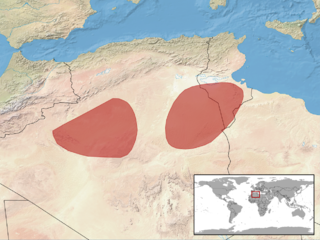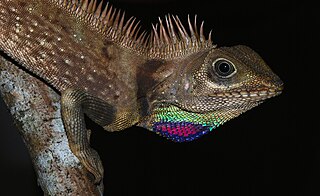
Gonocephalus is a genus of agamid lizards endemic to southeast Asia.
Hypsilurus is a genus of arboreal lizards in the family Agamidae. The genus is endemic to Melanesia.

Monilesaurus rouxii, commonly known as Roux's forest lizard, Roux's forest calotes, or the forest blood sucker, is a species of arboreal, diurnal, agamid lizard, which is endemic to hills of peninsular India. In July 2018, it was proposed that the species should be transferred to the new genus Monilesaurus.

Japalura tricarinata is a species of agamid lizard endemic to Asia.
Laudakia dayana, commonly known as the Haridwar agama, is a species of lizard in the family Agamidae. The species is native to extreme northern India.

Phrynocephalus theobaldi is a species of lizard in the family Agamidae. The species is endemic to Asia.

Salea horsfieldii, commonly known as Horsfield's spiny lizard or the Nilgiri salea, is a species of lizard in the family Agamidae. The species is endemic to the Nilgiri Hills of India. It is found mainly in the high altitude grassy hills. A related species, Salea anamallayana, is found in the grassy hills of the Anaimalai Hills.

Boyd's forest dragon is a species of arboreal lizard in the family Agamidae. The species is native to rainforests and their margins in the Wet Tropics region of northern Queensland, Australia. It is the larger of the two species of Lophosaurus found in Australia. Another species, the southern angle-headed dragon, L. spinipes, is found in southern Queensland and northern New South Wales.

The erg agama, also commonly known as the Sahara agama, is a species of lizard in the family Agamidae. The species is endemic to North Africa.

The Draconinae are a subfamily of reptiles in the family Agamidae found in southern Asia and Oceania. Some taxonomists believe these genera belong to the subfamily Agaminae.

Gonocephalus doriae is a species of arboreal lizard in the family Agamidae. The species is endemic to the island of Borneo.

Lophosaurus dilophus, the crowned forest dragon or Indonesian forest dragon, is a large arboreal agamid lizard found in New Guinea and the Moluccan islands, Indonesia.

Gonocephalus bellii, commonly known as Bell's anglehead lizard or Bell's forest dragon, is a species of lizard in the family Agamidae. The species is native to Southeast Asia and Oceania.

Lophosaurus is a genus of arboreal agamid lizards from Australia and Melanesia.

The Phuwua rock agama is a species of lizard within the family Agamidae. Mantheyus phuwuanensis is the only species in the genus Mantheyus. The species is endemic to Southeast Asia

Diploderma is a genus of lizards in the family Agamidae. Species of Diploderma are native to Myanmar, China, Vietnam, Taiwan, and Japan. Most of the species are found in China, including many endemics.
Diploderma dymondi, also known commonly as Dymond's japalure, is a species of lizard in the family Agamidae. The species is endemic to China.

Pseudocalotes floweri, also commonly known as Flower's forest agamid, Flower's long-headed lizard, and the Thai false bloodsucker, is a species of lizard in the family Agamidae. The species is native to Southeast Asia.
Hypsilurus godeffroyi, also known commonly as the angle-headed lizard, the northern forest dragon, and the Palau tree dragon, is a species of lizard in the family Agamidae. The species is native to Palau and Papua New Guinea.
Gonocephalus beyschlagi, also known commonly as the Sumatra forest dragon, is a species of lizard in the family Agamidae. The species is native to northern Sumatra, Indonesia.















